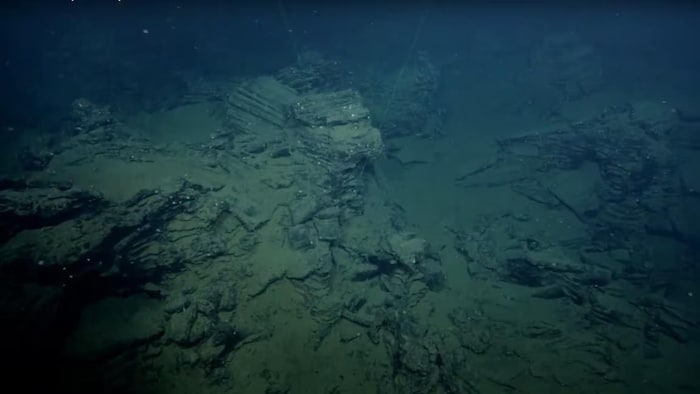Open in full screen mode This photo, taken in 2011, shows underwater basalt rocks in the Endeavor Zone of the Cascadia Basin in the Pacific Ocean. This type of rock is formed when magma comes into contact with water. (Archive photo) The Canadian Press Scientists from Ocean Networks Canada (ONC) predict that a magma eruption will take place within a few weeks to a few years off Vancouver Island. They detected up to 200 small earthquakes per hour in the region last week. The volcanic eruption could take place approximately 5 km deep and 260 km off the west coast of Vancouver Island. It will be too distant and too small to be of concern to the population. The phenomenon will offer a unique opportunity to learn more about the formation of Earth's crust. Martin Scherwath, an ONC scientist, said this would be the first time it will be possible to capture the phenomenon using underwater instruments. The Neptune observatory has in fact been collecting data on the site since the first installation of the equipment in 2009. It is therefore the first Once a cable network observatory is there permanently, and we really have the chance to understand what is happening, rejoices Martin Scherwath. Benoît Pirenne, director of user engagement at ONC, explains that these earthquake swarms are linked to the separation of the Juan de Fuca tectonic plate from that of the Pacific. A space is created between the plates, which allows underlying liquids to rise. When the very hot magma touches the water, there is a sudden cooling which freezes the lava, and which forms basalt cushions. This is how the earth's crust is formed. Loading ELSELL ON NEWS: Eric Girard presents the Quebec budget for 2024-2025Loading ELSE ON NEWS: Eric Girard presents the Quebec budget for 2024-2025< p class="StyledBodyHtmlParagraph-sc-48221190-4 hnvfyV">There will be a major propagation event, predicts Martin Scherwath. We want to know exactly how far it is spreading, how much new ocean crust it is generating, and how fast. Ocean Networks Canada says the observatory has detected increased seismic activity in the area known as the Endeavor segment of the Juan de Fuca Ridge for several years. This peaked on March 6, when the observatory recorded the highest level of seismic activity in nearly two decades. Last week's seismic activity was simply exceptional if we compare it with that which nevertheless increased gradually, details Martin Scherwath. There were maybe a few [jerks] per day on average, but 200 per hour is an exceptional number. It's still a lot, it's unusual, confirms Benoît Pirenne, who explains that 1873 earthquakes were counted during the day of March 6. During the last eruption 20 years ago, scientists only had seismometers on the ocean floor to gather information about earthquakes. This time, the data will be collected in near real time and will include additional equipment to measure temperature changes or any noise from lava breaking through the seafloor. The temperature of the magma is estimated to be around 800°C, but it will cool quickly when it hits ocean water. Martin Scherwath predicts that almost fluid, flowing rocks will rise from the seafloor, solidify and quickly turn black, while the heat causes the water around them to fizz. He said he and his fellow geophysicists will monitor how much of the Earth's crust is formed in a single eruption. Biologists will focus on how marine fauna react to these possible changes. With information from the show < /em>West Lighthouse
Eric Girard presents the Quebec budget for 2024-2025
Eric Girard presents the Quebec budget for 2024-2025
Off Vancouver Island, a spike in earthquakes heralds an underwater eruption

